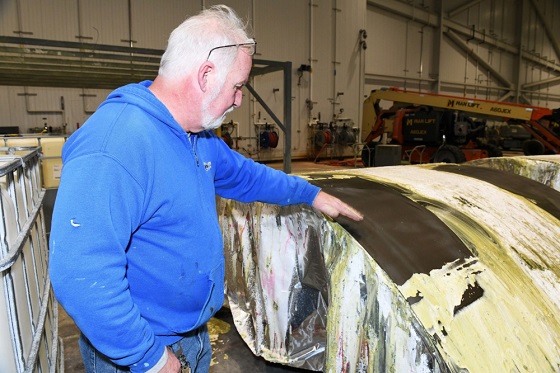The corrosion control team of the 558th Aircraft Maintenance Support Squadron (AMXSS) at Robins Air Force Base, Georgia, USA, regularly uses its craft to extend the service life of aircraft.
“The mission of corrosion control is to protect the aircraft,” says Todd Lavender, 558th AMXSS process engineer and squadron‘s corrosion control process manager. “It’s not for looks. It’s mainly for us to make sure there is not any corrosion associated with the aircraft so it can continue to fly longer.”
Aircraft Treatment Process
Once aircraft arrive at Robins for scheduled and programmed depot maintenance (PDM), they are processed and transferred to the corrosion control team for paint removal. “We masked the aircraft to begin the de-paint process,” he says. “Once that is completed, we apply a chemical mixture of benzyl-alcohol and hydrogen peroxide onto the aircraft that takes the paint off of the aircraft.”
Removing the paint from the aircraft is an important step. “It is important to de-paint the aircraft so you can make sure you see all the areas that have potential to corrosion,” Lavender says. “There are specific areas on the aircraft that are more prone to corrosion than others. De-painting the aircraft uncovers and exposes the surface so they can make repairs as needed to the aircraft.”
Once de-painted, the aircraft undergoes PDM and is returned to corrosion control to be painted, completing the PDM process. “The paint gate is seven to 12 days, depending on the aircraft,” Lavender explains. ““It takes approximately four hours to add primer and topcoat. All the other days are surface preparation for masking and sealing the aircraft.”
Once critical areas of the aircraft are masked, team members apply a non-chrome containing surface pretreatment over the surface, which helps the primer stick to the aircraft. The primer contains hexavalent chromium to protect the aircraft from future corrosion. Finally, once the aircraft has primer applied, it receives its topcoat.
“A C-5 aircraft is about 36,000 square feet [3,344.5 m2]; and volume wise, we have about 180 gallons [681.4 L] of primer on the aircraft,” Lavender says. “Then, we use about 220 gallons [832.8 L] of topcoat. The corrosion control paint portion takes about 3,000 man hours for each aircraft.” In all, it takes about 35 people to safely paint a large aircraft.

New COVID-19 Challenges
During the novel coronavirus (COVID-19) pandemic, Lavender’s team has faced a unique challenge.
“Throughout the pandemic, there were often times that manpower was reduced due to quarantine and isolation,” Lavender says. “Many times we had to combine painters from different areas within the support squadron. When you are accustomed to painting a specific airframe, it is sometimes difficult to quickly learn the techniques required to paint another airframe.”
Virtual reality (VR) technology provided a solution to the cross-training challenges brought on by the pandemic. “Currently, the Department of Defense is evaluating many different methods to effectively train our work force, specifically painting,” Lavender says.
A painter can cross-train in a VR atmosphere and gain necessary skills on a variety of aircraft.
“The future of virtual reality aircraft paint training will provide focused development of basic skills for painting an aircraft,” Lavender says. “The painter can transition into an augmented reality environment where they will have access to all of the pertinent information—air pressure, fluid pressure, pump pressure, fluid flow, mil thickness, etc.—they require to provide a quality paint finish.”
Customer Acceptance
A quality finish is what Air Force customers want to see, Lavender explains. “The first thing the customer sees is the paint job when the aircraft touches down at its home station,” he says. “So making sure you have a quality product leaving here is key to the customer accepting the whole aircraft. They do not see the work on the overhaul, but they see the paint job—and if they see a bad paint job, they assume the work may have been subpar, as well.”
With a plan to roll out VR aircraft paint training by mid-summer, Lavender is pleased with his team’s work.
“It is a good feeling to know that we produced a quality product that is helping to get boots on the ground,” he says. “The corrosion control mission extends the lifecycle of our aged aircraft that fly missions worldwide in support of the Air Force and the warfighter.”
Source: U.S. Defense Video Imagery Distribution System, www.dvidshub.net.
Reference
1 “WR-ALC Corrosion Control Mission Extends Aircraft Life,” Defense Visual Information Distribution Service News, Feb. 5, 2021, https://www.dvidshub.net/news/388483/wr-alc-corrosion-control-mission-extends-aircraft-life (March 20, 2021).